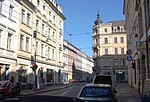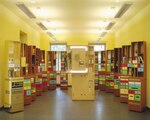Staatsschauspiel Dresden
1913 establishments in GermanyBuildings and structures in DresdenCulture in DresdenTheatres completed in 1913Theatres in Germany

The Staatsschauspiel Dresden (State Playhouse Dresden) is a theatre in Dresden. It is maintained by the Free State of Saxony, hence its name. It consists of a main auditorium, the Schauspielhaus (play house), and a studio theatre, the Kleine Haus. It was created in 1983 and housed in the old Staatstheater Dresden which traced back to a Royal Court Theatre.
Excerpt from the Wikipedia article Staatsschauspiel Dresden (License: CC BY-SA 3.0, Authors, Images).Staatsschauspiel Dresden
Glacisstraße, Dresden Innere Neustadt (Neustadt)
Geographical coordinates (GPS) Address Phone number Website Nearby Places Show on map
Geographical coordinates (GPS)
| Latitude | Longitude |
|---|---|
| N 51.0615 ° | E 13.751 ° |
Address
Kleines Haus
Glacisstraße 28
01099 Dresden, Innere Neustadt (Neustadt)
Saxony, Germany
Open on Google Maps










